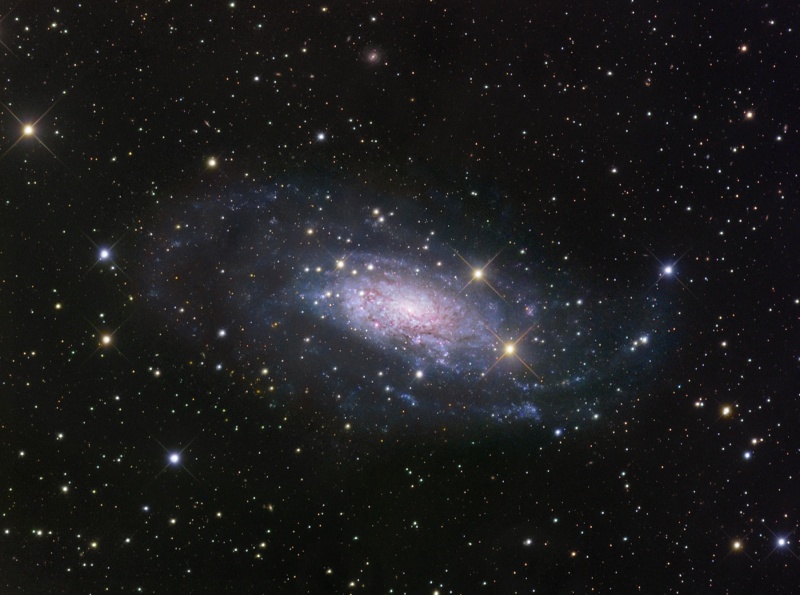The technological advances experienced in the last twenty years have made in amateur astronomy shooting the sky is no longer as craft work and sacrifice. Almost 10 years ago I gave last time a chemical emulsion film to capture the sky. Two years later, he would have my first CCD camera .
was passed hand to lead exposure for tens of minutes, from the field, in emulsions of 1000, 1600, 3200 ISO, even movies sensitized by most experts to obtain an image of deep sky galaxies able to take a minute footage shot with a simple instrument that has motorized tracking, and in an urban environment.
The new situation is the delight of all those fans who want to portray the beauty of the sky, they can get Messier objects easily, and squeeze the capacity of their telescopes to catch the faintest objects and the finer details. The computer also plays in his favor with the ability to process, enhance and draw every possible nuance of an image, combine multiple shots, and finally, taking beautiful and evocative photos of galaxies, nebulae and star clusters. My esteemed and admired colleague Ramón Naves calls these astrophotographers , sarcastically, postaleros . I will avoid at all times that the treatment can suggest contempt for astrophotography aesthetic is a detailed work resulting in a successful outreach. A beautiful image and delight the public interest in astronomy. For years I was pretty enthusiastic about astrophotography no great achievements, so respect for postaleros for their dedication and effort.
however, and is one reason for this blog, the technology allow astronomical image capture sky objects: asteroids comets, variable stars, double stars, galaxies, quasars , etc, in images which can then extract information from the position in the image or the distribution and brightness. We obtain astrometry , that is, a very precise measurement of its position in the celestial coordinate system, or photometry, a moderately accurate measure of its brightness.
An observer today, with a telescope of less than 20 inches in diameter, may file a weak supernova in a distant galaxy, with magnitude 14 or 15, and once, in a program on your PC, you can get its brightness value in the standard system of magnitudes, and their equatorial coordinates accurate to within 1 arcsecond of error. Several decades ago, only professional astronomers could obtain this information, and also only after a tedious process that could last for weeks, examining boards with micrometer or measuring the light by photoelectric photometers.
This image of the galaxy NGC3621 is wonderful, is made by a large astrophotographer was astronomical image of the day on 19 September 2009 on the web of NASA, and we can learn much about astrophysics carefully examining , but we used to do photometry. To give its final appearance was necessary to combine a series of shots that have been previously processed and altered in its tonal range. Robert Gendler image .
In this image quite ugly, we see only an ordinary star field. It also presents a gradient of brightness caused by light pollution . Is a sum of 10 images of 60 seconds each for an exposure equivalent to 10 minutes. Have joined such images and how they left the chamber, only processed to subtract the noise and dark current correction flattening field (flat field , which has not even come to fix it at all by a bloody specks of dust).
By working on the picture you have adjusted the brightness levels for optimal viewing , but without changing the original values \u200b\u200bof accounts. But in this picture we can measure the brightness of stars displayed registered, that is, to photometry, for example, that object marking aspect stellar, but it's not a star in our galaxy, but a distant quasar known do by the name OJ 287.
When we take pictures to obtain data, there are beautiful views, but we soon realize that there is much room to play on, we can see how the stars change their brightness, how supernovae explode and vanish , we realize that the sky is alive and constantly changing!
By working on the picture you have adjusted the brightness levels for optimal viewing , but without changing the original values \u200b\u200bof accounts. But in this picture we can measure the brightness of stars displayed registered, that is, to photometry, for example, that object marking aspect stellar, but it's not a star in our galaxy, but a distant quasar known do by the name OJ 287.
When we take pictures to obtain data, there are beautiful views, but we soon realize that there is much room to play on, we can see how the stars change their brightness, how supernovae explode and vanish , we realize that the sky is alive and constantly changing!
In this picture, the most soda We dedicate ourselves to measure the brightness of the star indicated. Taking pictures during successive days and measured the same star we realize that their brightness is different from one day to another:
brightness values \u200b\u200bmake a prima facie scattered appearance, but be warned intervals. By a mathematical algorithm shows that the data show a periodicity of 3.3 days. If we average the points and adjust as we get
phase That star anodyne was seen in the image is a Cepheid variable star , called CK Camelopardalis , and we've achieved this typical brightness curve with our own images and process the data in our computer. Cepheid variable stars are very important in astrophysics because cosmic distance indicators.
Supernova 2005cs in the galaxy Messier 51. This image is a copy of the original image has been extracted photometry of the supernova . In some cases, especially if it is supernovas in other galaxies, photometry images to become beautiful.






0 comments:
Post a Comment